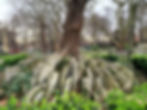The Thomas Hardy Tree
3 min readThis unusual tree growing through stacked gravestones in Camden, North London, is believed to have been created by the author Thomas...
This unusual tree growing through stacked gravestones in Camden, North London, is believed to have been created by the author Thomas Hardy when he worked there in the years before finding fame for his novels. Having stood firm for 160 years, the tree was sadly felled by a storm in December 2022, but its legacy lingers on and there are plans for a suitable memorial to this unique feature in a London graveyard.

Hardy was working in London after his early years in the far more rural Dorchester, where he grew up in poverty – living in one of the most beautiful homely cottages you will ever find, and which is open the public. His family were unable to afford education for him beyond the age of 16 and so he was apprenticed to a local architect. After working on various local projects such as the church next to the impressive Athelhampton House, he moved to London and enrolled in Kings College, joining Arthur Blomfield’s practice as an assistant architect.
In the mid 1860s, the Midland Railway was being created to go through what is now Kings Cross-St Pancras and the cemetery of St Pancras Church was needed for its route. The church is thought to be one of the oldest Christian sites in the country and had fallen into disrepair by the early 1800s. In 1847 it underwent a period of restoration with drastic changes being made to the building, and burials ceased in 1854 with the Extramural Interment Act, going instead to the St Pancras and Islington Cemetery which was opened in nearby East Finchley. In 1865 the Bishop of London hired Blomfield’s firm to supervise the proper dismantling of tombs and exhumation of the graves, and Blomfield passed the task to his protégé Thomas Hardy.
The bodies were moved without their headstones, leaving the problem of what to do with them. The solution was to stack them around a young ash sapling – possibly intended as a temporary measure, but they remained there and over the years the sapling grew into a tree, its trunk and roots growing through the stones.
Hardy returned to Dorset after only five years in London, worried about his health, disliking the city and acutely aware of the social divisions amongst its inhabitants. He probably never gave the tree a second thought, but over the years its fame grew, for many symbolising the triumph of life over death, and it received a steady trickle of visitors. The church put up a hedge barrier to protect it and the ash survived for at least 160 years before a storm in December 2022 snapped the trunk and destroyed it for good.
I was very lucky to visit it not long before its demise. There are plans to ensure that the gravestones remain protected and that some sort of memorial is maintained but what that will look like is yet to be determined.



